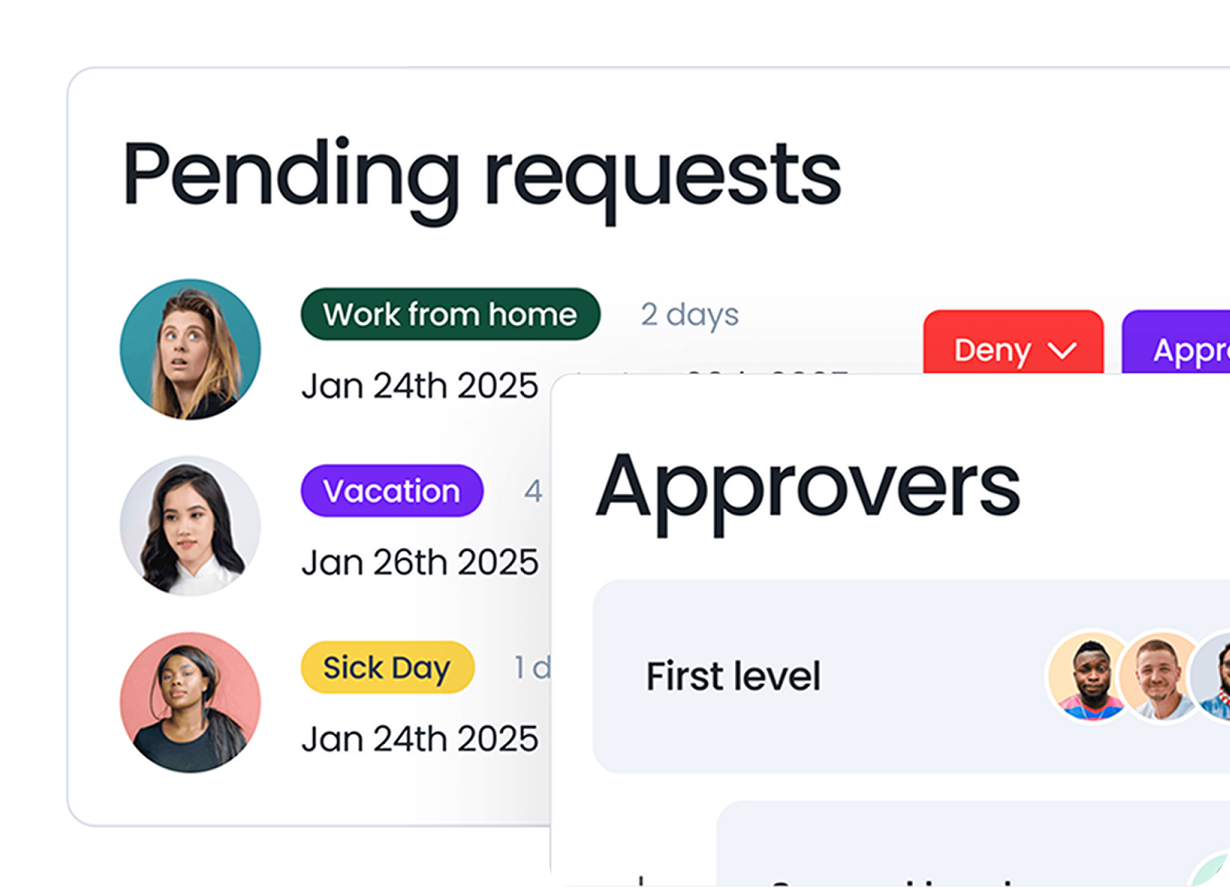Last updated on July 18, 2025
Once considered a perk, remote work has become a new normal over the past years, with over a third of U.S. workers with remote-capable jobs working from home. And even though it comes with a wide range of benefits, remote work also has its challenges.
When working from home, it’s harder to set boundaries between our professional and private lives. It’s not so uncommon to open our laptops in the morning, do some house chores in the middle, and end up staying up late since our attention and productivity are hindered. All of this can lead to burnout, which can take a toll on our health, happiness, productivity, and the quality of our work.
If you’re looking for practical ways to identify and address work-from-home burnout, we’re here to help. Keep reading to explore the main symptoms, causes, and helpful solutions to address this increasingly widespread issue.
What is Remote Work Burnout?
Remote work burnout occurs when employees experience physical, mental, and emotional symptoms caused by extended periods of stress when working from home. This often results in feelings of cynicism or hopelessness and can impact an employee's performance at work as well as their overall well-being.
While burnout is commonly caused by work-related stressors, it can impact every aspect of an individual’s life, including their personal lives and interpersonal relationships. This is why it can be first noticed among colleagues but also family and loved ones.
Here are some telltale burnout symptoms you may want to look out for:
- Poor performance at work
- Poor productivity levels
- Problems focusing
- Increased absenteeism
- Lack of motivation
- Chronic fatigue
- Irritability and short temper
- Anxiety
- Depression
Burnout is often more difficult to spot in remote teams than in-office staff because there are inevitably fewer interactions and less connection between colleagues. The isolation caused by working from home is a significant cause of the syndrome, as well as a reason prevention can be challenging. But don’t worry, we’re here to help you navigate it all.
![]()
Key Causes of Remote Work Burnout
Overworking
The rise of remote work has created an “always on” culture, causing employees to feel less entitled to all forms of leave, from sick days to personal days and vacation time. The mentality is that because they are home and often enjoy flexible hours, they can make time for their personal and professional life without taking time off.
As a result, 38% of remote employees experience burnout because they feel pressured to work more hours, leading to a situation where they never fully disconnect and ultimately become completely exhausted.
Blurred Work-Life Boundaries
When your office and your living room become one and the same, it’s not always easy to separate your personal life from your professional obligations. There is so much more overlap now between these two worlds; Employees will find themselves hearing notifications ping on their computer while trying to unwind and watch TV and feel obligated to answer. Flexible hours and remote work culture have created this inability to segment time and space for work and personal activities, resulting in 61% of remote workers struggling to unplug after hours.
Isolation
Isolation is a huge factor when we discuss declining mental health and burnout in remote teams. It’s inevitable that offices become a place to socialize, where coworkers often turn into friends and interactions expand beyond work-related or surface-level topics. In-person interaction will always be more powerful at fostering connection and community. This is why remote employees are 98% more likely to suffer severe work loneliness in comparison to in-office staff. Superficial interactions, or none at all, combined with staying home all day, can be extremely unhealthy and demoralizing.
How to Prevent Remote Work Burnout
Promote Healthy Boundaries
Remote work can blur the lines between personal and professional life, making it tough for employees to disengage after hours. As HR managers, it’s essential to create a culture that promotes healthy work-life boundaries. Help your team understand the importance of setting up dedicated workspaces and defining their schedules. Some companies even offer budgets for employees to create a comfortable and productive home office environment, which can make a significant difference.
Encourage staff to disconnect from notifications and resist the urge to check emails or messages after working hours. By championing these practices, you’ll not only support your employees in maintaining a work-life balance but also help prevent work-from-home burnout in the long run.
Encourage Breaks and Time Off
Although remote workers do have more freedom and control over their schedules, that doesn’t mean they’re not at risk for burnout. Remote employees need to use their PTO to unplug, destress, and recharge. Yet, they take 5.5% less leave than in-office workers.
It’s a business’s responsibility to ensure that employees understand the importance of PTO and feel comfortable requesting it. Managers must lead by example, taking time off to reduce the stigma. If this is not effective enough, teams have sometimes resorted to implementing a mandatory PTO policy to make sure all employees take a minimum number of days off.
Tracking leave is essential to monitor PTO trends to keep track of who’s at risk for work-from-home burnout. This includes studying who’s often on sick leave, as well as who has not taken a single day off all year. We know that leave tracking can be a daunting task for many, however, with the help of automation, managers can do it effortlessly. Vacation Tracker integrates seamlessly into Microsoft Teams and Slack to help companies track their leave in just a few simple steps. Plus, our exportable leave balance reports make it easy to analyze everyone’s habits and ensure they’re maintaining a healthy work-life balance. Curious to see our app in action? Try it free for 7 days!
Implement a Flexible Schedule
Even though remote employees don’t have to waste their time commuting, spend money on ordering takeout for lunch, and buy as many clothes as they would if they were coming to the office, they still have a life beyond work that needs to be attended to. Everyday chores and duties can hinder employees’ productivity and the quality of their work.
Flexible schedules allow employees to work when they feel most productive and finish their non-work-related responsibilities without endangering their jobs. If necessary, determine a time when everybody has to be present at work to ensure overlap for meetings and collaboration.
Build a Strong Remote Company Culture
Combat the loneliness epidemic by prioritizing culture and implementing activities to allow your team to connect in a less formal way. There are so many ways companies can achieve this, and it really depends on your company’s size, location, budget, and overall collaboration style.
At Vacation Tracker, we get together for one week each year in a fun destination to brainstorm but also socialize and have fun! This helps break down the barrier of the screen and truly get to know one another, especially members of teams you might not often get to work with.
A more accessible option would be to implement virtual happy hours or water-cool style slack channels to chat about anything they like, except work! If your team is remote but living in the same region, consider team lunches, group activities, or days in a co-working space to change up the routine and get teams out of their home.
Offer Support
36% of workers report that their company has no measures to prevent employee burnout. Don’t fall into this margin!
If employee wellness is something your organization prioritizes, you’ll need to put that into practice through policies and benefits that support remote employees when they need it most. This includes workshops to help with stress management and counseling or therapy coverage.
Management should be proactive, checking in with employees regularly and creating an environment where teams feel comfortable talking to their leaders. Virtual office hours are another great way to provide employees with the space to voice their thoughts. It’s one of several strategies that can make remote team management more personal, responsive, and sustainable over time.
To do this effectively, managers can block off specific time slots dedicated to addressing quick questions or issues. Locking the meeting room when someone joins ensures privacy and encourages open communication.
Feedback and Recognition
Nothing feels better than knowing you’re doing a great job. Recognition is motivating and can help prevent employees from feeling discouraged or underappreciated. Plus, it’s free and takes nearly no time.
To encourage company-wide recognition, consider gamifying the process through simple integrations in Slack or Microsoft Teams. Apps like HeyTaco encourage teams to provide daily recognition, with those offering and receiving the most recognition winning real-life prizes, like gift cards or company swag! This not only boosts employee engagement and morale but also cultivates a positive team spirit.
Leveraging Technology to Combat Burnout
The frequency of remote work is continuing to increase, with an estimated 36.2 million Americans working remotely by 2025. We don’t want the number of stressed-out, unhappy employees to continue to rise either.
Keep a close eye on your team and monitor how they act and perform at work. But remember, tracking success isn’t just about output—PTO matters too!
With Vacation Tracker, you can effortlessly monitor employee leave patterns to proactively address any stress indicators and identify those at risk of burnout. Employees can easily see their leave allowances and request time off digitally through the app, making them feel more comfortable asking for PTO. A shared calendar and scheduled notifications provide visibility into current and upcoming time off, creating an environment that normalizes taking breaks and encourages a healthier work-life balance.
![]()
Want to learn how to combat burnout with Vacation Tracker? Request a demo today to see how effective leave management can transform your team’s well-being!
Learn how to manage time off without
Tracking Can Be
confusion, delays, or admin headaches. 

Claudia
Claudia is an experienced marketer with a passion for writing and creating engaging content that connects with readers.




